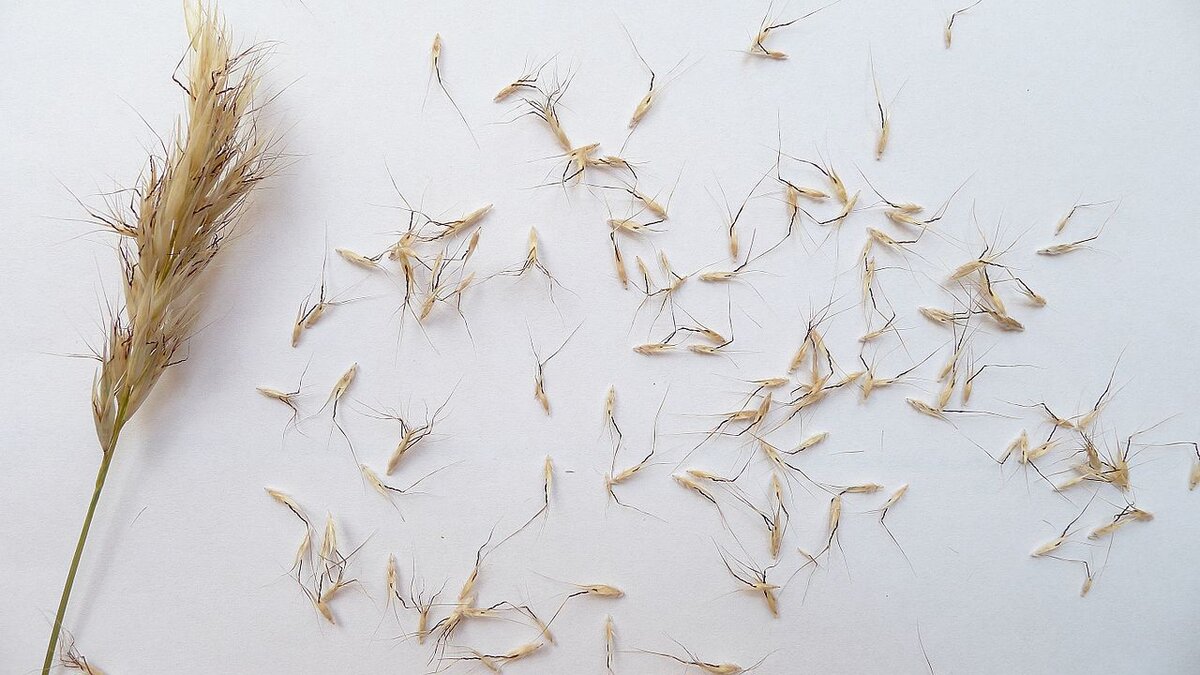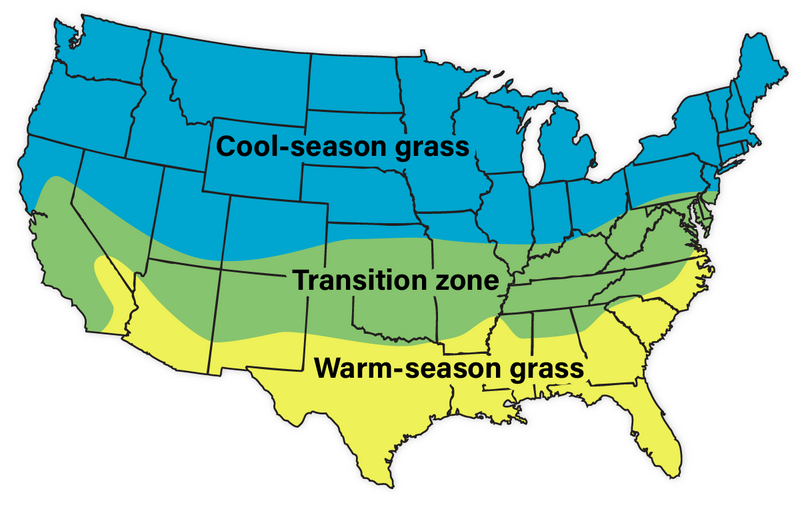
Your lawn’s circle of life doesn’t need to begin and end with expensive, packaged seed. Harvesting your own grass seed is an easy, natural way to save money and transform your lawn into a sustainable sanctuary. You’ll feel like a real backyard farmer, and you won’t have to rush to the store every time your lawn needs some extra seed.
If you time it right, you can store grass seed to overseed your lawn every growing season. So put on your straw hat and read on to learn how to harvest your own grass seed.
4 steps to harvest grass seed
What you need
- Existing lawn grass
- Your own hands
- Gloves
- A cloth or plastic bag to collect seeds
- Sieve to filter seeds
- Scissors or grass shears to cut seed heads (optional)
- Handheld brush harvester to collect seeds (optional)
- Strong, airtight container for long-term storage
Step 1: Choose your harvesting location
The best place to harvest seed is an area of your lawn that gets partial to full sun where grass grows well. Your perfect spot shouldn’t be full of sneaky weeds: You don’t want to end up spreading a lovely layer of weed seed all across your lawn.
How do you decide your harvest area’s size? It depends on how large your lawn is and how much of it requires overseeding. For a full overseeding, you’ll need about 2 to 4 pounds of seed per 1,000 square feet of lawn.
Step 2: Stop mowing
To allow your seed heads to fully mature, stop mowing the area where you’ll be collecting seeds. Continue watering and wait about 20 to 30 days after your grass has flowered to begin harvesting. Generally, you’ll want to stop mowing in the middle to the end of summer.
How to tell when your seeds are ready for harvest:
Test your grass by cutting a few seed heads in different areas of your lawn. Check the color of the seeds: If they are green, they’re not ready. If they’re tan, orange, or golden, take it one step further: Squeeze the seeds.
If a seed feels soft and squishy (like a tiny piece of dough), then it needs a bit more time. If medium to hard pressure from your thumbnail is needed to dent the seed, then it’s firm and ready for harvesting.
Another easy test? Hit the seed head roughly with your palm. If the seed top shatters (the seeds pop out of the seed head), those seeds are ready for harvest. You’ll want 75 percent of seeds to be mature before you begin harvesting.
Pro Tip: Seed heads ripen from the top down, so when checking the color, look at the whole flower head and not just the seeds at the top of it.
Step 3: Collect seeds
There are three ways to harvest seeds in the backyard. You can collect seeds with:
- Your gloved hands
- Grass shears or scissors
- A handheld brush harvester
The best option for you depends on how large your area is, how much time you’ve got, and how much you’re willing to sweat.
To collect seeds with your hands:
This is the simplest, most laborious method that’ll make you feel like you’re in Little House on the Prairie.
- Put on gloves to protect your fingers from tiny turf burns.
- Hold the base of the inflorescence (the flowering portion of your grass that extends from the stem) with one hand.
- Using your other hand, slide your thumb and index finger upward to the top of the plant, gently squeezing as you go.
- Seeds will accumulate at the top of your fingers. Collect the seeds and deposit them into your seed bag.
- Move to the next plant and repeat the process.
- After collecting seeds, mow your lawn on a high lawn mower setting following the one-third rule: Cut only one-third of your grass’s total height during any given mow to prevent lawn damage.
To harvest seeds with scissors or grass shears:
Instead of squeezing each plant individually to release seeds, you can cut your grass and deposit it directly into your seed bag. This still requires a lot of crouching or kneeling, but it’s less fingerwork.
- Cut grass stems just below the bottom of the seed heads.
- Place cuttings into your grass bag. Loose seeds will fall to the bottom of the bag, and the rest will remain in the seed heads as they dry and then fall to the bottom of the bag.
- Let seeds dry. Keep your seed bag in a cool, dry place away from pests.
- Shake it up! Shake the bag occasionally to prevent grass spikes from sticking to each other.
- After six to eight weeks, vigorously shake the seed bag one final time. Then, pour seeds out into a new container, using a sieve to separate them from the excess plant matter.
- Store until the next growing season.
Pro Tip: To embrace the “reduce, reuse, recycle” theme, compost the dry excess plant material.
To harvest seeds with a handheld brush harvester:
A handheld brush harvester is quite an investment, but it’ll do almost all the work for you. If you’re planning to harvest your grass every year, or if manual harvesting is tough on your back, a handheld brush harvester is the way to go.
- Walk with your brush harvester across your lawn, cutting your grass right below its seed heads.
- Depending on the variety of harvester you buy, it may be helpful to rotate your body side to side to maximize the number of seed heads you collect.
- Pour the contents of your harvester through a sieve to strain out organic matter like leaves and twigs.
- Refilter the contents if necessary to minimize excess plant material. Then, store your seeds.
Step 4: Store your seeds
Once you’ve filtered your seeds from the other organic matter, store them in an airtight container in a cool, dry place to prevent fungus and pests. Rodents love grass seed, so remember to store your seeds in a squirrel-proof container. It’s a good idea to store bags of seed in a galvanized metal trash bin or tightly sealed glass jars.
The storage area should not be prone to temperature fluctuations or humidity: High levels of moisture are mold’s best friend, and moldy seeds won’t germinate.
If you have a thermometer and a hygrometer (used to measure relative humidity), use this handy rule: The sum of the relative humidity and temperature should never be above 100. So if your area has 50 percent relative humidity, it should always stay 50 degrees Fahrenheit or cooler.
Under the right conditions, your seeds will be set to germinate when you plant them next season.
When to harvest seed
Harvest your seed 20 to 30 days after your grass has bloomed, but before it releases its seeds. It’s important that you only harvest once seeds have fully matured. If you harvest green, moist seeds, they won’t germinate. Likewise, if you harvest too late, seeds will have already fallen to the ground.
The perfect time to harvest your seed depends on where you live and what grass variety you have.
When to harvest cool-season grass seed

Cool-season grasses (grown in the top half of the U.S.) tend to bloom in late spring or early summer, so you’ll want to harvest them in mid-July to late August.
| Type of grass | When to harvest |
| Bentgrass, bromegrass, canarygrass, and orchardgrass | Late July to early August |
| Tall fescue and Kentucky bluegrass | Early August |
| Perennial ryegrass | Late July to late August |
| Wheatgrass | Early September |
When to harvest warm-season grass seed
Warm-season grasses (grown in the bottom half of the U.S.) tend to bloom in late summer, so you’ll want to harvest seeds in late August to late October.
| Type of grass | When to harvest |
| Common bermudagrass* | Late August to early September |
| Centipedegrass | Late October |
| Buffalograss** | Late August |
* Most hybrid bermudagrass varieties do not have seeds to harvest.
** Make sure you’re harvesting the right buffalograss seeds: It’s easy to mistake male flowers (which have no seed value) for female seeds. Female burrs (the protective shell containing seeds) tend to be buried deep in the turfgrass, so you’ll really have to dig.
Harvesting and overseeding can be tough if you live in the South because many warm-season grass plants are grown only as sod or plugs and do not produce viable seeds. Harvesting seed isn’t an option for most hybrid bermudagrass, St. Augustinegrass, and Zoysia lawns.
Pro Tip: Not sure when you should harvest based on your particular region? Your local cooperative extension office is a great resource for information on your region’s specific harvesting times.
Why harvest seed instead of buying it?
When your grass is looking thin and could use a hearty overseeding, or when your lawn is developing bare spots and needs to be reseeded, you’ll have to fork over quite a chunk of change for new seed. To overseed an average-sized, 10,000-square-foot lawn, seed mixes can run from $60 to $140.
Adding in the cost of labor, many homeowners pay hundreds of dollars to have their lawn prepared and overseeded. If you aerate and overseed your lawn by yourself using your own seed, your savings stack up.
Want to do your part for the planet? Harvesting your own grass seed is eco-friendly: Seed companies expend energy to grow seed (using fertilizer and herbicide), package it, and ship it to garden centers. When you harvest your own seed, you reduce your hidden carbon footprint.
FAQ about how to harvest grass seed
The fresher your seeds, the more likely they are to establish strongly and sprout. While you can store your seeds for up to one year, it’s best to use seeds from last season for this season to ensure high germination rates and reduce the risk of bare spots.
Yes! While your type of grass and climate play large roles in seed maturation rates, weather extremes and unexpected temperature fluctuations are also important to take into account.
Hot, dry weather tends to increase the rate of seed maturation, whereas seeds in cool, moist conditions take longer to mature. If your region has had a particularly dry summer, check on your grass seeds earlier in the season to see if they’ve matured.
The best time to plant grass seed depends on your region. If you live in the upper half of the U.S. and have cool-season grass, overseed in late summer to early fall. If you live in the lower half of the country and have warm-season grass, overseed in late spring to early summer.
Celebrate the harvest
Harvesting your own grass seed is an easy way to reuse what you already have, save money, and feel fantastic about your environmental impact. You can be a real home grower, transforming your lawn into a more sustainable, low-waste space.
If you need a hand overseeding your new grass, or if you want to aerate first for a healthy green boost, don’t hesitate to call a local lawn care pro.
Main Photo Credit: John Tann from Sydney, Australia | Wikimedia Commons | CC BY 2.0